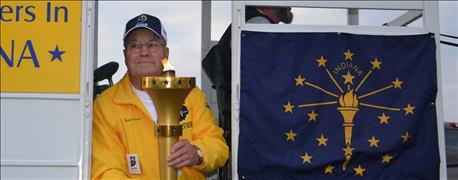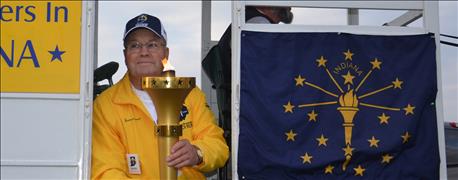
The Indiana Bicentennial Torch Relay in September and October was all about honoring the spirit of Hoosiers by recognizing accomplishments of the past and pointing the way toward the future. Agriculture was represented in some way in almost every county along the relay. Perhaps agriculture was lifted up as high as it would be anywhere when the torch relay visited Elkhart County.
About 400 people showed up early in the morning and gathered under a big tent in a pasture on Mike and Judy Oesch’s Mybrook Farms along Highway 20 east of Middlebury. Cars filled the parking area, and tractors of all ages lined the road leading to the site.

FITTING RIDE: The bicentennial torch left Mybrook Farms in Elkhart County in good hands. Truman Weaver, a retired dairyman, carried it in an antique horse-drawn milk wagon.
“We thought it would be a nice touch, so neighbors helped, and we lined our county road with tractors,” Mike Oesch says. The tractors were primarily John Deere green, Farmall red and white, and Case IH red, with models ranging from the early days of tractors to modern-day machines.
Lift up dairy
Dairy is still vital to northern Indiana’s economy, and the Elkhart County organizing committee wanted to make sure everyone knew it. Jerry Goshert, a member of the committee, which planned the event, led everyone in a milk toast just before the torch was lit.
“That was certainly unique,” says Mark Newman, director of Indiana Tourism. “A lot of counties did interesting things, but the milk toast was unique.” Instead of the clinking of wineglasses, the sound of plastic milk jugs tapping together rang through the tent.
Truman Weaver was selected to be the first torch bearer in Elkhart County. A retired Guernsey breeder who served two terms on the National Guernsey Breeders board of directors, Weaver says his maternal great-grandfather moved to his current farm in Elkhart County in 1865. “I’m the fifth generation to farm this place,” he noted in his application to be a torch bearer.
Weaver rode out of Mybrook Farms in style. He climbed aboard an antique milk wagon pulled by a horse. Weaver carried the torch with its burning flame as he rode along on the first leg of the torch’s journey in Elkhart County.
Look to future
The purpose of the Bicentennial Torch Relay was to celebrate Indiana’s past and help Hoosiers rekindle a spirit of pride in Indiana. It also pointed the way to the future.
The torch itself burned E85 ethanol fuel along its journey. Ethanol already accounts for using up about one-third of the corn produced in the state, and could figure heavily in Indiana’s future ag economy.
The cauldron used to light the torch was designed and built by students and faculty at Purdue University. Students from various disciplines, primarily engineering, cooperated to design and build the unit that gave new life to the torch each day, Newman says.
Indiana will look to Purdue for innovative breakthroughs in engineering and other fields in the future.
About the Author(s)
You May Also Like




